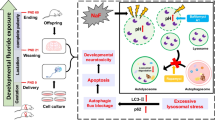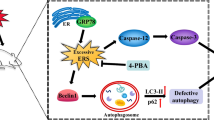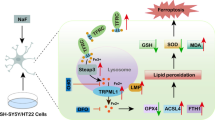Abstract
2-(2-benzofu-ranyl)-2-imidazoline (2-BFI) is a drug that has attracted much attention in recent years. It has a therapeutic effect on brain diseases in animal models such as Alzheimer’s disease and cerebral infarction. However, whether 2-BFI affords neuroprotection against the toxicity of fluoride, which can cross the blood–brain barrier and cause neurological dysfunction is not known. We investigated the cell viability and apoptosis of SH-SY5Y cells and primary cultures of cortical neurons exposed to fluoride, and 2-BFI was used to protect both two kinds of cells against the effects of fluoride. We found that 2-BFI can provide neuroprotection on SH-SY5Y cells and primary cultures of cortical neurons upon fluorosis by maintaining the stability of endoplasmic reticulum–mitochondria contact sites and inhibiting activation of the NLR family pyrin domain containing 3 (NLRP3) inflammasome. This study may provide a new method for protecting against the neurotoxicity induced by fluoride exposure.









Similar content being viewed by others
Data Availability
The data supporting the conclusions of this article will be made available from the corresponding author on reasonable request.
References
Neurath C, Limeback H, Osmunson B, Connett M, Kanter V, Wells CR (2019) Dental fluorosis trends in US oral health surveys: 1986 to 2012. JDR Clin Trans Res 4(4):298–308
Zeng XX, Deng J, **ang J, Dong YT, Cao K, Liu XH, Chen D, Ran LY, Yang Y, Guan ZZ (2020) Protections against toxicity in the brains of rat with chronic fluorosis and primary neurons exposed to fluoride by resveratrol involves nicotinic acetylcholine receptors. J Trace Elem Med Biol 60:126475
Yu X, Chen J, Li Y, Liu H, Hou C, Zeng Q, Cui Y, Zhao L, Li P, Zhou Z, Pang S, Tang S, Tian K, Zhao Q, Dong L, Xu C, Zhang X, Zhang S, Liu L, Wang A (2018) Threshold effects of moderately excessive fluoride exposure on children’s health: a potential association between dental fluorosis and loss of excellent intelligence. Environ Int 118:116–124
Spittle B (1994) Psychopharmacology of fluoride: a review. Int Clin Psychopharmacol 9(2):79–82
Razdan P, Patthi B, Kumar JK, Agnihotri N, Chaudhari P, Prasad M (2017) Effect of fluoride concentration in drinking water on intelligence quotient of 12-14-year-old children in mathura district: a cross-sectional study. J Int Soc Prev Community Dent 7(5):252–258
Garcia-Lopez AL, Hernandez-Castillo J, Hernandez-Kelly LC, Olivares-Banuelos TN, Ortega A (2020) Fluoride exposure affects glutamine uptake in muller glia cells. Neurotox Res 38(3):765–774
Zhang C, Yang Y, Gao Y, Sun D (2022) NaF-induced neurotoxicity via activation of the IL-1beta/JNK signaling pathway. Toxicology 469:153132
Chen R, Zhao LD, Liu H, Li HH, Ren C, Zhang P, Guo KT, Zhang HX, Geng DQ, Zhang CY (2017) Fluoride induces neuroinflammation and alters wnt signaling pathway in BV2 microglial cells. Inflammation 40(4):1123–1130
Shah FA, Kury LA, Li T, Zeb A, Koh PO, Liu F, Zhou Q, Hussain I, Khan AU, Jiang Y, Li S (2019) Polydatin attenuates neuronal loss reducing neuroinflammation and oxidative stress in rat MCAO models. Front Pharmacol 10:663
Csordas G, Weaver D, Hajnoczky G (2018) Endoplasmic reticulum-mitochondrial contactology: structure and signaling functions. Trends Cell Biol 28(7):523–540
Markovinovic A, Greig J, Martín-Guerrero SM, Salam S, Paillusson S (2022) Endoplasmic reticulum-mitochondria signaling in neurons and neurodegenerative diseases. J Cell Sci 135(3):248534
Nagashima S, Takeda K, Ohno N, Ishido S, Aoki M, Saitoh Y, Takada T, Tokuyama T, Sugiura A, Fukuda T, Matsushita N, Inatome R, Yanagi S (2019) MITOL deletion in the brain impairs mitochondrial structure and ER tethering leading to oxidative stress. Life Sci Alliance 2(4):e201900308
Kelley N, Jeltema D, Duan Y, He Y (2019) The NLRP3 inflammasome: an overview of mechanisms of activation and regulation. Int J Mol Sci 20(13):3328
Lee HJ, Jung YH, Choi GE, Kim JS, Chae CW, Lim JR, Kim SY, Yoon JH, Cho JH, Lee SJ, Han HJ (2021) Urolithin a suppresses high glucose-induced neuronal amyloidogenesis by modulating TGM2-dependent ER-mitochondria contacts and calcium homeostasis. Cell Death Differ 28(1):184–202
Tian JS, Zhai QJ, Zhao Y, Chen R, Zhao LD (2017) 2-(2-benzofuranyl)-2-imidazoline (2-BFI) improved the impairments in AD rat models by inhibiting oxidative stress, inflammation and apoptosis. J Integr Neurosci 16(4):385–400
Han Z, Cheng ZH, Liu S, Yang JL, **ao MJ, Zheng RY, Hou ST (2012) Neurovascular protection conferred by 2-BFI treatment during rat cerebral ischemia. Biochem Biophys Res Commun 424(3):544–548
Tian J, Chen R, Hu L, Zhang L, Chen J, Cao Y, Guo X, Wang L, Han Z (2018) The protective effect of 2-(2-benzonfu-ranyl)-2-imidazoline against oxygen-glucose deprivation in cultured rat cortical astrocytes. Neurosci Res 133:1–6
Wu X, Zhao J, Yu S, Chen Y, Wu J, Zhao Y (2012) Sulforaphane protects primary cultures of cortical neurons against injury induced by oxygen-glucose deprivation/reoxygenation via antiapoptosis. Neurosci Bull 28(5):509–516
Brookes PS, Yoon Y, Robotham JL, Anders MW, Sheu SS (2004) Calcium, ATP, and ROS: a mitochondrial love-hate triangle. Am J Physiol Cell Physiol 287(4):C817–833
Sun L, Ma W, Gao W, **ng Y, Chen L, **a Z, Zhang Z, Dai Z (2019) Propofol directly induces caspase-1-dependent macrophage pyroptosis through the NLRP3-ASC inflammasome. Cell Death Dis 10(8):542
Schroder K, Tschopp J (2010) The inflammasomes. Cell 140(6):821–832
Wei W, Pang S, Sun D (2019) The pathogenesis of endemic fluorosis: research progress in the last 5 years. J Cell Mol Med 23(4):2333–2342
Khan SA, Singh RK, Navit S, Chadha D, Johri N, Navit P, Sharma A, Bahuguna R (2015) Relationship between dental fluorosis and intelligence quotient of school going children in and around Lucknow district: a cross-sectional study. J Clin Diagn Res 9(11):ZC10–ZC15
Zhang C, Ren C, Chen H, Geng R, Fan H, Zhao H, Guo K, Geng D (2013) The analog of Ginkgo biloba extract 761 is a protective factor of cognitive impairment induced by chronic fluorosis. Biol Trace Elem Res 153(1–3):229–236
Erpapazoglou Z, Mouton-Liger F, Corti O (2017) From dysfunctional endoplasmic reticulum-mitochondria coupling to neurodegeneration. Neurochem Int 109:171–183
Bousquet P, Feldman J, Schwartz J (1984) Central cardiovascular effects of alpha adrenergic drugs: differences between catecholamines and imidazolines. J Pharmacol Exp Ther 230(1):232–236
Lione LA, Nutt DJ, Hudson AL (1996) [3H]2-(2-benzofuranyl)-2-imidazoline: a new selective high affinity radioligand for the study of rabbit brain imidazoline I2 receptors. Eur J Pharmacol 304(1–3):221–229
Leng F, Edison P (2021) Neuroinflammation and microglial activation in Alzheimer disease: where do we go from here? Nat Rev Neurol 17(3):157–172
Jayaraj RL, Azimullah S, Beiram R, Jalal FY, Rosenberg GA (2019) Neuroinflammation: friend and foe for ischemic stroke. J Neuroinflammation 16(1):142
Bravo-Sagua R, Parra V, López-Crisosto C, Díaz P, Quest AFG, Lavandero S (2017) Calcium transport and signaling in mitochondria. Compr Physiol 7(2):623–634
Rossi A, Pizzo P, Filadi R (2019) Calcium, mitochondria and cell metabolism: a functional triangle in bioenergetics. Biochim Biophys Acta Mol Cell Res 1866(7):1068–1078
Lim JR, Lee HJ, Jung YH, Kim JS, Chae CW, Kim SY, Han HJ (2020) Ethanol-activated CaMKII signaling induces neuronal apoptosis through Drp1-mediated excessive mitochondrial fission and JNK1-dependent NLRP3 inflammasome activation. Cell Commun Signal 18(1):123
Missiroli S, Patergnani S, Caroccia N, Pedriali G, Perrone M, Previati M, Wieckowski MR, Giorgi C (2018) Mitochondria-associated membranes (MAMs) and inflammation. Cell Death Dis 9(3):329
Zhou R, Yazdi AS, Menu P, Tschopp J (2011) A role for mitochondria in NLRP3 inflammasome activation. Nature 469(7329):221–225
Acknowledgements
We are thankful for the technical support provided by Professor Ruiqin Yao (Xuzhou Medical University).
Funding
This study was supported (HAB201932) by the Natural Science Foundation of Huai’an City, Jiangsu Province, China. and (XWKYHT20200064) Medical Science and Technology Innovation Project of Xu’zhou Health Commission for Young Scholars.
Author information
Authors and Affiliations
Contributions
RC: investigation, and writing of the original draft. WX and YS: investigation and writing (review and editing). RZ and ZZ: data analyses. PX: data analyses, resource acquisition, experimental validation, software accrual. CZ and XT: conceptualization and supervision of the study.
Corresponding authors
Ethics declarations
Conflict of interest
There is no conflict of interest to disclose.
Not applicable.
Additional information
Publisher’s Note
Springer Nature remains neutral with regard to jurisdictional claims in published maps and institutional affiliations.
Rights and permissions
Springer Nature or its licensor holds exclusive rights to this article under a publishing agreement with the author(s) or other rightsholder(s); author self-archiving of the accepted manuscript version of this article is solely governed by the terms of such publishing agreement and applicable law.
About this article
Cite this article
Chen, R., Xu, W., Sun, Y. et al. 2-BFI Provides Neuroprotection Against Fluorosis by Stabilizing Endoplasmic Reticulum–Mitochondria Contact Sites and Inhibiting Activation of the NLRP3 Inflammasome. Neurochem Res 48, 591–603 (2023). https://doi.org/10.1007/s11064-022-03781-z
Received:
Revised:
Accepted:
Published:
Issue Date:
DOI: https://doi.org/10.1007/s11064-022-03781-z




